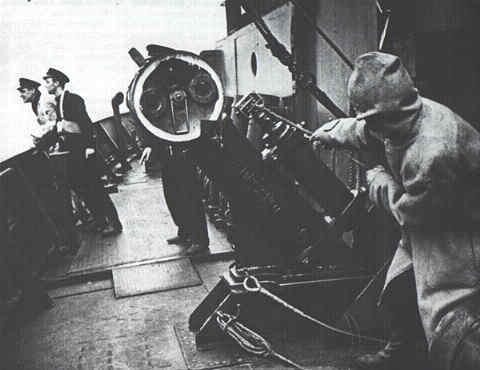The depth charge is the oldest anti-submarine weapon, being developed during World War One. Original idea dates back to the "dropping mine" concept of 1911. The Royal Navy Commander in Chief, Sir George Callaghan requested its production in 1914. The first effective depth charge (Type D) was the 300-pound (140 kg) barrel-like casing containing high explosives, normally TNT being developed in 1916. A "pistol" actuated by water pressure at a selected depth detonated the depth charge.
The 300-pound WWI depth charge could be detonated as deep as 300 feet (roughly 100 meters) but at the eve of that was the more formidable 600-pound (270 kg) version was developed.

A K-gun just before firing
The first means of delivery was to simply roll the "barrels" of a special rack at the stern of the escort vessel. Eventually a special depth-charge projector or "K-guns" were developed. These could, by means of an explosive propellant charge, hurl the depth charges out to the side of the escorts for a distance of roughly 50 meters.
When the K-guns and the stern charges were used together that enabled he escort to lay a pattern of 9 or 10 charges onto the suspected U-boat's position.

A depth charge in flight after being fired from a K-gun
Even though the massive explosive power of the 600-pound charge was impressive to both the escort and the U-boat, highly unnerving to the latter even, the depth charge was not the answer to the U-boat threat. The pressure hull of the U-boat was strong enough to withstand anything but a charge exploding 10 or 20 feet from its hull. To place the weapon this close to the U-boat was extremely difficult to say the least, especially since the U-boat normally took drastic evasive maneuvers at the very last moment. Thus most U-boats that were sunk by depth charges alone probably sank due to accumulated damage from repeated depth charge attacks. Many U-boats survived as many as 300 depth charges over a period of many hours.
In 1943, Torpex a 50% more powerful explosive than TNT, was introduced along with a more streamlined depth charge casing that resulted in an improved sinking rate of the weapon. This was of course an improvement yet a great deal of U-boats escaped its grasp.
The more appropriate answers to the U-boat threat were the Hedgehog forward-throwing charges and the American Mk. 24 acoustic torpedoes known as "Fido".
The greatest amount of depth charges dropped on a single U-boat during a single-hunt in the war is believed to be 678 dropped onto U-427 in April, 1945. Amazingly the boat survived the onslaught.


